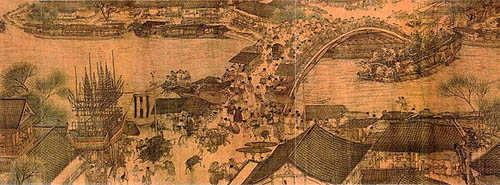I recently picked up an accordion-bound copy of Zhang Zeduan’s famous Song dynasty painting of a scene during the Qingming festival. The painting is so famous that a New York Times article described it this way: “Like the Mona Lisa, ‘Qingming Festival’ is to some extent famous for being famous.” It has been copied, reinterpreted, and converted into different media. (In fact, my earliest memory of it is recognizing the famous bridge as the same as the semi-3D wooden model hanging from the wall of a Chinese restaurant I used to go to.) The reproduction that I bought has some variations from the original, but from what I can tell those differences are only on the ends and in an additional top margin area. However, it’s possible that I’ve got a reproduction of a fairly, though not completely, faithful copy. As of this writing, the Wikipedia article on the painting is pretty interesting, including information about the city supposedly represented, various translations of the title into English, and so forth.

I bought it mainly because the Qingming festival is so important, at least traditionally, to the tea industry in China. This festival, occurring in the first week of April, represents something like the start of the “regular” spring season. Teas harvested before the Qingming festival (called “mingqian” teas) are considered to be exceptional. These teas are the ones that are expected to have the most concentrated flavor compounds because the tea plants have been building up their nutrient reserves over the winter. Teas made after Qingming traditionally decreased in value as the date of harvest got further and further from the festival, for much the same reason. Later-picked spring teas would be second, third, fourth pickings from the same bushes and would, therefore, be ever so slightly less full of the stuff needed for a truly amazing cup of tea.
My personal take-away, though, is that it’s another reason to do your part reducing climate change, like driving less, using sustainably produced products, eating smaller amounts of non-poultry meats, using energy efficient lighting and appliances, and so forth.
Also, Tea Geek Business Members can check out my reproduction of this famous painting through the Tea Geek Library Service.








Climate change is only one reason why you can more/fewer pickings.
Qing Ming, along with nearly all the traditional Chinese holidays, is calculated according to the lunar calendar. Just as the date of Jewish Passover changes year to year, the date of Qing Ming is not fixed. If it arrives earlier (e.g. in mid to late March), the weather and temperature conditions may not allow as many MingQian harvests.
Jason
walkerteareview.com
Is it really on the lunar schedule? I found several references to Qingming falling on the 15th day after the spring equinox, meaning it would actually be a solar-based festival landing in most years on either April 4th or 5th. But, I have to admit I didn’t dig really deeply on that particular point so it could be incorrect. Do you have direct knowledge or resource?
You are right- it does appear to be one of the few holidays in the traditional Chinese calendar (Nong Li) based on solar events.
Have you found that division of labor contributes to more mingqian harvests? I imagine that farmers can spend more time in the field, catching those subsequent harvests at the optimum time when they used to be out of the field, hand processing the first harvest. Dragonwell farms I’ve seen were small. In some cases, one family could process their grown teas from harvest to wholesale/retail.
I had the chance to see that painting in person when it was on display in Hong Kong. It is truly stunning! The amazing part is how small it is. It is long, but not very tall and the detail added to each person and building was amazing. I would have a hard time drawing such details with a fine pen, much less a paint brush. I’ve asked around and from what the old timers and professors I know say, Qingming Jie is based on the Lunar Calendar.
Thanks for the tip on this little piece of Chinese culture. It’s just fitting that the Chinese would have their Mona Lisa be about the tea calendar. That I think is totally cool. I’m going to look for a cheap print of this for myself.